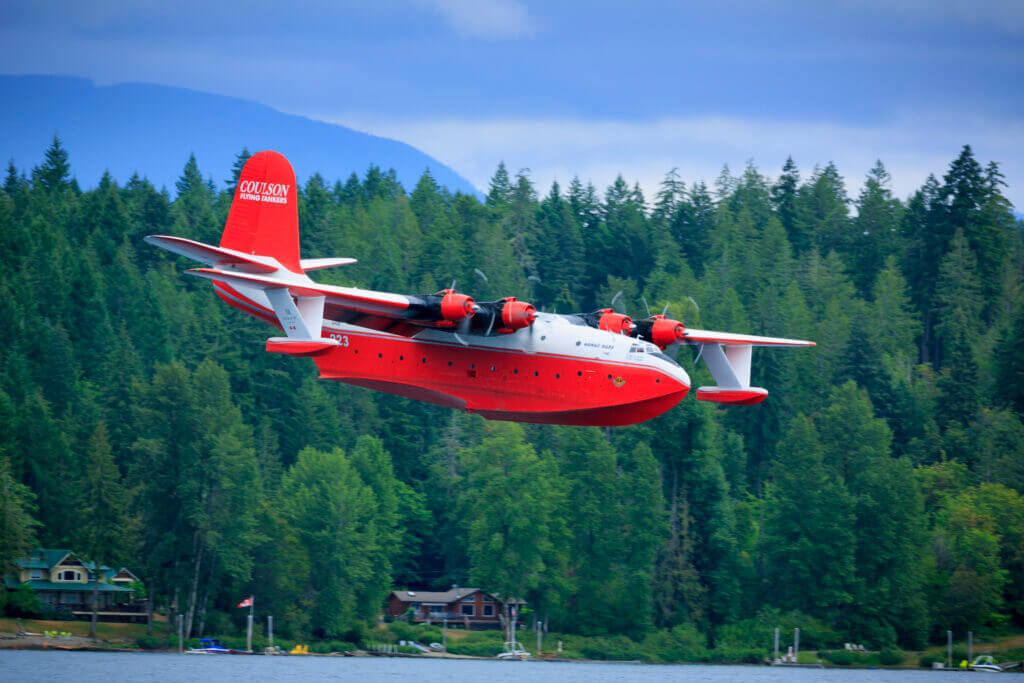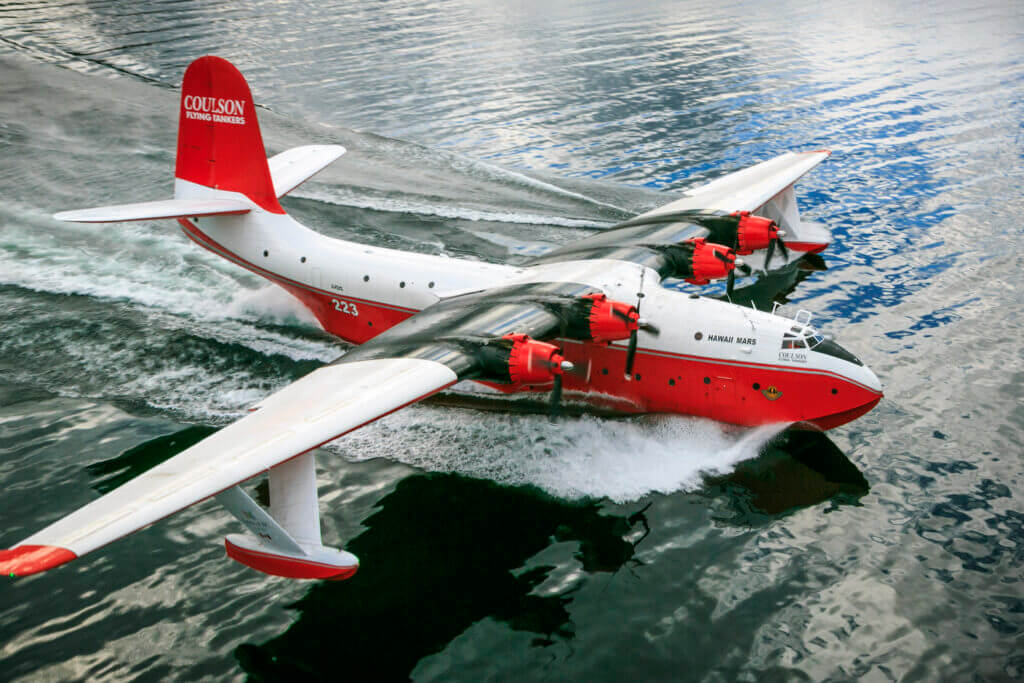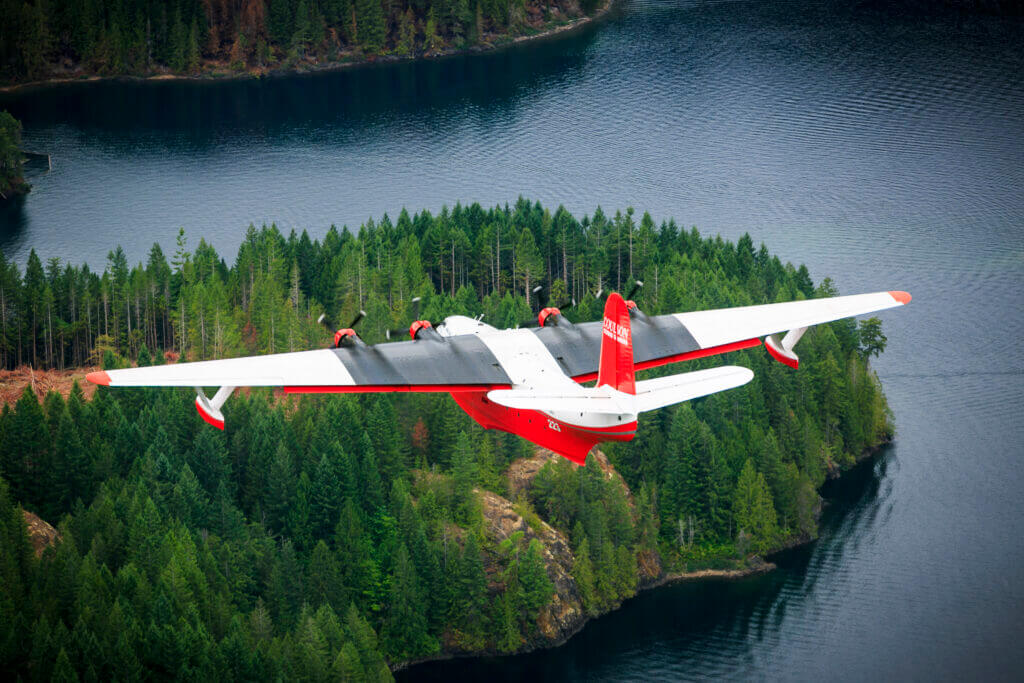Estimated reading time 8 minutes, 31 seconds.

Coulson Aviation has found a final resting place for its 1945 Martin Mars waterbomber, known as the Hawaii Mars, a key part of British Columbia history and one of only two aircraft of the type known to have survived.
The iconic Hawaii Mars will be donated to the British Columbia Aviation Museum, where it will form the centrepiece of a wildfire aviation exhibit.
“We have let go of the disappointment of having to retire the world’s greatest waterbomber, and now focus on its amazing aviation history, which dates back to 1945 when it was delivered to the U.S. Navy,” said Coulson Aviation in a statement.
The Martin Mars is among the largest aircraft ever built, a giant “flying boat” that served for several decades in B.C. firefighting missions after being retired from military service in the late 1950s.
Over a span of 55 years, two Mars aircraft — both acquired by Coulson in 2007 and known as the Hawaii Mars and the Philippine Mars — dropped over 50 million gallons (roughly 189 million litres) of water on wildfires, the company said.
“These airplanes are the undisputed world champions in aerial firefighting water delivery and have undoubtedly proven the concept of an initial attack at the start of a wildfire,” said Coulson.
“It has been an honour for our family to be entrusted with these aircraft and the hope they represent for the public in time of need as we have all been negatively impacted in some way by the devastation of wildfire.”
Preparations to retire the Hawaii Mars are set to begin immediately, with its final flight from the Coulson Aviation Tanker Base in Port Alberni, B.C., to Victoria International Airport expected in late summer or early fall.

Coulson will enlist a team of five former certified maintenance engineers and four flight crew to complete about 10,000 hours of aircraft maintenance and “flight retraining” over the next six months, according to the B.C. government.
The province is providing $250,000 in one-time funding for the project.
“The Hawaii Martin Mars waterbomber is a proud symbol of B.C.’s ingenuity and innovation, representing cutting-edge technology in aviation firefighting of its time,” said Lana Popham, the province’s minister of tourism, arts, culture and sport.
“We recognize the value the Hawaii Martin Mars waterbomber holds for many people and have heard their desire to have it housed in the British Columbia Aviation Museum, where it can be displayed and protected as an important piece of our province’s history.”
The Hawaii Mars requires water to take off and land, so it will settle at Saanich Inlet, near the Victoria airport, and then to Canadian Coast Guard Base Patricia Bay, a former seaplane port. At Patricia Bay, the aircraft will be brought up on a ramp, mounted on a trailer, and hauled across runways at the airport.
During its military service with the U.S. Navy, the Hawaii Mars was a transport carrier and served as an air ambulance during the Korean War. It was last deployed in the summer of 2015 to extinguish wildfires in B.C., California, Mexico, and Alberta.
Only six Martin Mars aircraft were initially manufactured for the Navy, and two were lost during military operations. The remaining four aircraft, along with several spare parts, were sold to Forest Industries Flying Tankers (FIFT), a consortium of B.C. forestry companies, in the late 1950s, according to B.C. Aviation Museum.

Fairey Aviation of Canada converted the aircraft into waterbombers at Victoria International Airport, and the first entered wildfire service in 1960. An aborted drop resulted in a crash that claimed the lives of four crew and destroyed the Marianas Mars aircraft in 1961, per the museum. A little more than a year later, Typhoon Freda destroyed the Caroline Mars.
This left only the Hawaii Mars and the Philippine Mars, which went on to fight over 4,000 forest fires using their massive 27,000-litre load capacity. Vancouver Islanders frequently gathered to watch these aircraft as they soared in action during wildfire season, with their 2,500-horsepower Wright R3350-24WA engines turning 16-foot propellers.
“While it will be a monumental project just to get it here, it will be one big jewel in our
crown,” said Steve Nichol, president of the B.C. Aviation Museum. “The Hawaii Mars has real historical and cultural value.”
The museum’s wildfire exhibit already displays several aircraft, and there are plans to build a third interactive hangar to house the Mars and other planes, along with flight simulators that will allow guests to virtually fly the Mars on waterbombing runs.
“I was lucky to witness many demonstration practice drops when I swam at the lake often as a kid, and then later I knew of its extensive use when I was in forest firefighting,” said Richard Mosdell, project lead for the Save the Mars Team.
“Now after these past two years of discussions … this huge rescue puzzle is finally being solved so that everyone can hear these same stories and even sit way up in the cockpit of this iconic aircraft.”









I have been all through this aircraft at Sprout lake and at one time was asked if I would consider overhauling the engines for this aircraft when I still owned Okanagan Aero Engine in Kelowna. I finally decided it would be too much for the small shop we had. Great aircraft. Ed Haasdyk
Hey it would have been really great to say WHERE the Aviation Museum is exactly. Not everyone know.
What is the statue of Philippine Mars?